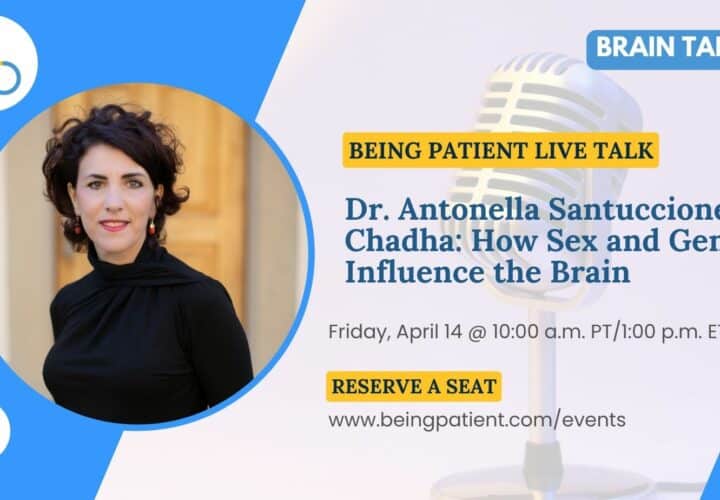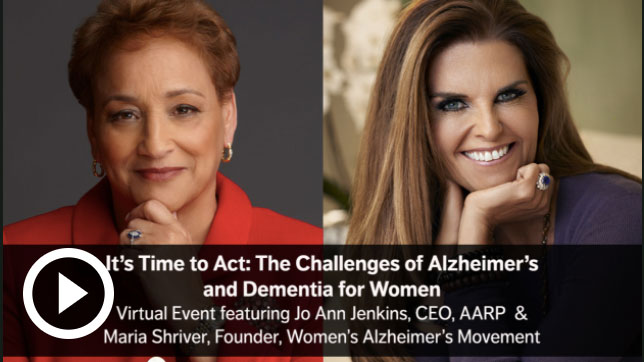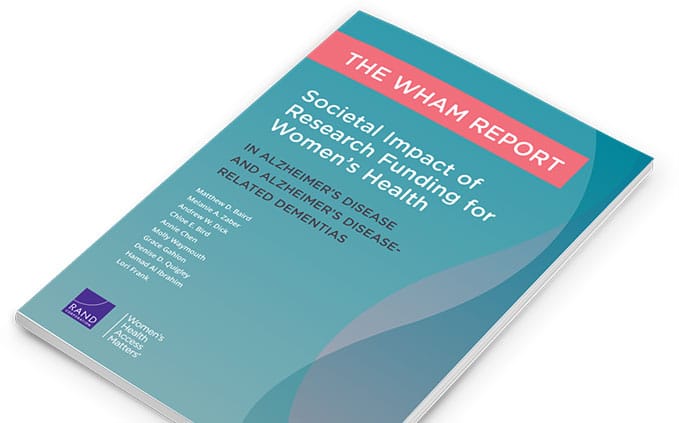Two thirds of people diagnosed with Alzheimer’s are women. Women’s Brain Project CEO Dr. Antonella Santuccione Chadha talks about investigating link between dementia, sex, and gender.
Of the 30 million living with Alzheimer’s worldwide, two thirds are women. While it was previously thought that it was because women lived longer, evidence shows that Alzheimer’s biomarker tau protein accumulates differently and more quickly in women’s brains.
In 2016, a group of friends decided to get to the science of the prevalence of Alzheimer’s in women.
“We were three friends, female scientists, with respective kids pulling us left and right,” Dr. Antonella Santuccione Chadha recalls. “We said, ‘You know what, we heard from some prominent philanthropic colleagues in the United States that Alzheimer’s is more female. Let’s go and understand the science and the reason why.’”
Coming from a science background, Santuccione decided: “Let’s put the evidence on the table. Because those American colleagues were not coming from science. We were the scientists. So, we got inspired. And our mentors, including my mentor, was the founder of Lecanemab, right? When he, the discoverer of Lecanemab, asked us, “Is it really needed?” We said, “Yes, it is.”
With the association officially registering in 2017, the Women’s Brain Project was born. The organization’s mission is “to transform the development of drugs and medical treatments through sex and gender factors as a gateway to precision medicine and care.” The organization does this by running research projects, consulting with industry partners, engaging with organizations, and developing novel technologies for new treatment options.
Chadha, CEO of the Women’s Brain Project, recently joined Being Patient Live Talks to discuss the organization’s research on sex, gender, and the brain. A medical doctor, Chadha is an internationally recognized clinical pathology, neuroscience, and psychiatric disorders, expert. She’s the Chief Medical Officer at Altoida Inc. and is the co-founder of the Women’s Brain Project. In her pro-bono work with the organization, she’s dedicated to researching the influence of sex and gender on mental and brain diseases.
In this conversation, she provides insights into her research and the work the Women’s Brain Project is currently doing. Watch the full conversation, or read a transcript from the conversation below.
Being Patient: Are really differences in women’s brains that make some more predisposed to Alzheimer’s. What do we know about this in terms of research?
Dr. Antonella Santuccione Chadha: Well, what is known is that, indeed, the female brain is more prone to develop those neurodegenerative diseases like Alzheimer’s. There are several risk factors that are specific to women. For example, one of those is the menopausal phase that we must go across at a certain point in life.
These hormonal changes might predispose women to have a higher sensitivity to developing Alzheimer’s disease. It is speculated that this is due to the fact that estrogen is a kind of neuroprotective and the drop in estrogen that one experiences during menopause might be one of the predisposing factors. There are also other reasons that might be due to the fact that we are women.
One of those that I like to spell out very loud and clear is that we are the majority of caregivers worldwide. So, this is not really related to the sex of the individual but rather to the gender of the individual. Being a caregiver, especially when you do care full time, is a specific risk factor for depression, but also for dementia. This is due to social isolation. This is what we learned, also, thanks to the work that several researchers worldwide have done, but then has been endorsed and reinforced by the recommendation of how to prevent Alzheimer’s disease.
Indeed, social isolation is one of the major causes of this condition. We also have other reasons that relate to the immune system. So, we go back to the biological aspects of the disease and why we are more predisposed than men. Apparently, it’s a matter of what is known as neuroinflammation, which leads to a higher accumulation of toxic protein. Women tend to have a higher predisposition to having a high level of tau deposition in the brain. Tau is one of the neurotoxic proteins that accumulate in the brain in what we describe as plaques, one of the major causes of the disease.
“Being a caregiver, especially when you do care full time, is a specific risk factor to depression, but also to dementia.”
Being Patient: How much do we know about the interaction between hormones and brain health?
Chadha: It’s still highly discussed, and the research is not very clear. I mean, we also don’t really know if hormone replacement therapy might be protective or not. So, there is a high debate. I can tell you that even the number of pregnancies has been speculated to be related to the predisposition to develop Alzheimer’s. Research has to really understand what that link is.
Certainly, we know that some women are more resilient, and they have that brain reserve that might delay the onset of the symptoms of the disease. What we also know is that the accumulation of toxic protein starts very early in the journey of this condition, even 20 years before.
You can imagine that if you maybe have the type of lifestyle that prevents the onset of the disease in a very healthy form, then you are on a good path, and you are a lucky individual. The people that might not have that type of either brain reserve or brain resilience or that specific lifestyle that will prevent the early symptoms to appear, then they might develop the disease a little bit earlier. It’s a multifactorial condition where many players have a role.
As we said, women certainly are at the center of this condition, and more research has to be done to understand why.
Being Patient: What research is being done to understand that link? Do you have any examples?
I can tell you a set of data that we want to now carefully analyze, you might have certainly heard in the hope of the approval of those disease-modifying treatments. Aducanumab was one of the first, and then we had, on the sixth of January this year, the approval of Lecanemab.
Those are two molecules, highly related antibodies, immunotherapy. I’ve seen the first data about Aducanumab and there was one study that was in the laboratory where the molecule was developed here in Zurich around the corner. I was surprised by the fact that there was a set of data in the FDA Medical Review pointing to the fact that this immunotherapy might have worked better in the male population versus the female one.
But you know what it was about Aducanumab, I said, let’s watch and wait. It’s just a trend. It’s not really powered to study to understand those differences, then, you know, we got data about Lecanemab, and there was the same type of result. It seems that the drug works better in the male population versus the female population. We had at the recent congress seated in Gothenburg two weeks ago that the data about gantenerumab and certain antibodies were disclosed. Now, gantenerumab was not proven effective in reducing the symptoms, but it was proven effective in reducing the plaque. Once again, what it came out is that it acts better in the male population versus the female one. So, they also showed that women have more targeted positions. What I’m trying to tell you is that there is evidence pointing to these major differences.
What is the real cause? We still don’t know if it is purely biological, if it is gender combined with biology if it’s really due to estrogens or other cause that relates to the drop of estrogen during menopause and increased, for instance, neuroinflammation we know that women who also why going through menopause get more predisposed to the disease. We need to do better science to understand the reason why. In my opinion, we also need to do a better study designed to characterize early enough all these changes, and also the specific changes between men and women, because the data start to point at this. So, the call to action from us as scientists is, let’s analyze those data, let’s put the data together, let’s make some meta-analysis, or let’s say make a post hoc analysis to really understand if this trend that we saw in this big data set a statistical significance or a clinical significance.
“We need to do better science to understand the reason why.”
Being Patient: A lot of people are so surprised when I say this, but the truth is, it’s an infuriating fact that women weren’t even allowed into studies until the late 70s. So, research has a long way to catch up, and there are very few women-focused studies.
Chadha: It took us 20 years to arrive at this momentum. I think it is also a great opportunity to better understand why and how to tailor that therapy to the male body or brain versus the female one. Maybe it’s a matter of age, or maybe it is a matter of how we metabolize those antibodies. What I’m saying is it needs to be better understood. Nobody is to blame. It is just to improve medicine. It’s improved the way we do science and understands the fine-tuning of this finding because they could unlock completely unknown mechanisms. And then, as I said, adjust those age-adjusted ministration routes or even make a female, as you said, a specific study. We, in fact, advocate in these cases of multifactorial complex diseases for studies that eventually include only women. Why not?
Being Patient: At one time, it was believed that it was just a matter of women living longer than men being the reason that there were more women with Alzheimer’s. But that changed— why did that change? What did we find out that made us go, “It’s not just an age factor”?
Chadha: It is not just an age factor, indeed. Actually, the sad news that I can give you in addition to that is that although women tend to live those couple of years longer, the quality of life is much worse because comorbidities and chronic diseases in women that debilitate them profoundly suggest that they live much worse. There is one piece of data that might be very interesting for you. It was presented by the OECD, pointing to the fact that those states that provide the data have certainly confirmed that Alzheimer’s disease is more frequent in women. Interestingly enough, women are also the ones that get more often institutionalized, and sadly enough, they also receive a higher prescription of antipsychotics.
Now, you might know that antipsychotics are a proxy indicator of a poor standard of care. They are not really a specific treatment for Alzheimer’s, and they are certainly not the cure for the disease. This is saying that women, yes, they might live longer, but it’s not an advantage for them. As we said, there are more comorbidities, more institutionalization, and even higher prescription of antipsychotics. So, again, the reason why must be clearly understood. I think that the immune system plays a major role. It’s not yet very well characterized how our brain might be inflamed, eventually, more than the one of a man. We know that other types of diseases have an inflammatory component. Let’s think about Multiple Sclerosis. It’s exactly the same, 80 percent of women. If you think about anti-NMDA receptor encephalitis, it is a rare form of encephalitis due to antibodies against the brain again, and it’s mainly in females.
So, there might be some intrinsic predisposition to a woman’s body. Women’s immune systems and interconnection with the brain might predispose our brain to a higher susceptibility to these types of diseases. It’s not only Alzheimer’s. It’s migraines, it is multiple sclerosis, it is depression and anxiety. Again, depression, as we said at the beginning of our conversation, predisposes people to the risk of developing dementia. If 80 percent of the patients who have depression are women, you understand they are much higher, more predisposed than a man to develop dementia. It’s interconnected.
“It’s not only Alzheimer’s. It’s migraines, it is multiple sclerosis, it is depression and anxiety.”
Being Patient: We have a question from the audience. What’s the best data to look at the natural history of Alzheimer’s and women? Does that exist?
Chadha: Well, I would say that one of the most formative types of study in this regard is the FINGER study. I don’t know if you heard about it or if your audience knows the study, but a professor came up to me, and she’s doing a phenomenal type of study and characterizing how the disease evolves and how to implement specific measures. To prevent the disease from progressing further, one of those is cognitive training. Certainly, you have to keep the risk of diabetes or hypertension under control, you have to keep on exercising, and you need to be socially engaged. We said that already. You have to correct for your loss, your loss, it’s a specific risk of dementia. Nobody really talks about it, there is a high correlation between cognitive decline and hearing loss. So to correct your loss, it is fundamental if you want to age healthy, and if you want to age engaged with the rest of society minimizes the risk of getting dementia. So, this is certainly one of the best registries to really understand the subtype differences between specific predispositions to assign men and women, and she’s doing this type of analysis.
Being Patient: Could you tell us more about The Women’s Brain Project and your goals?
Chadha: We were the first organization there, around the world, to communicate to the media, “Be careful, there are more men dying from COVID rather than women.” And we knew that because we had a colleague that was in China trying to help the affected area, and she was sending us information and data. So that is what we do. We advocate for sex and gender analysis in research and drug development, but also in novel technology design.
I am also the chief medical officer of a startup that is using digital technology to study the brain and analyze it with a test that you can do on an iPad. Now, with this, what we also did was basically generate the scientific evidence that we want to achieve. We call it the Women’s Brain Project. Do you know why? Because a project has a beginning and an end. I want this to be my legacy to the world that, in 10 years, this debate will be over. This project has to be finished because we solved the project. We solved the problem and finally understood the implications of sex and gender differences in how we disease.
“We call it the Women’s Brain Project. Do you know why? Because a project has a beginning and an end.”
Being Patient: What’s next for the Women’s Brain Project?
For the brain and beyond, we are establishing a sex and gender precision medicine research Institute in Switzerland with a global reach out. We are collecting the funds for doing this.
And you know, our research never ends, we just got on the front page of Lancet Neurology. Here’s why. Because we just did work with the economic impact unit to understand the economic implication of neglecting sex and gender differences when we do neuroscience and research for neuroscience. Because when you give a tag in terms of, you know, economic return, then people start to understand what it’s all about.
This conversation has been edited for length and clarity.




